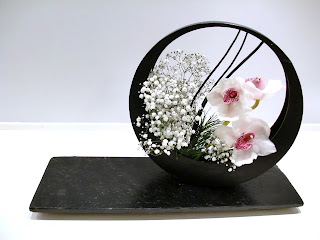Jeg er så heldig at jeg hver dag kan nyte denne utsikten, både fra kjøkkenbordet, stue og hage.
Denne utsikten har ofte gitt inspirasjon til ikebana arrangement og også til haiku dikt (japansk poesi).
Morgensolen fra Oslofjorden
siger ut over
bordet mitt
Haiku dikt ved: L.Lerum
Inspirasjon fra Oslofjorden og seilebåter.
Fristil, masse og linje (Bok 3, Leksjon 13)
Enda en soldag
synker bak åsen
også mauren bøyer hodet
Haiku dikt ved: Berit Østbye
Inspirasjon fra solnedgang over Oslofjorden.
Fristil, tørt og friskt materiale (Bok 4, Leksjon 13)
Fjorden mørkner
rundt Nesoddlandet
månen bærer slør
Haiku dikt ved: Berit Østbye
Fristil, arrangement i månevase, masse (Bok 3, Leksjon 12), slør-arrangement.
Fristil, arrangement i månevase, masse og linje (Bok 3, Leksjon 13).
Inspirasjon fra natt i hagen min.
Haiku
The Japanese Haiku is the most
direct, objective and highly concrete poetic form to be found in world
literature.
Haiku contains the tree
elements traditionally considered necessary:
A reference to a particular
occurrence.
A reference to nature. And
a sense that the occurrence in the poem is immediate happening.
Japanese Haiku follows as a
rule the principle of 5-7-5 syllables in a three line poem.
Mossy pond
frog jumps in
great splash
Basho
It
reveals that what is going on at a particular moment in a particular place,
stands
for the whole fabric of reality in the entire life of the universe.
One
of the fascinating aspects of haiku that may reflect the influence of Zen,
is
the practice of bringing together seemingly disparate elements by showing
their
hidden or unsuspected unity.
The
haiku must have present experience from
a fresh point of view.
The
Jap. haiku differs most from western poetry in its non – intellectuality.
A
good haiku does not interpret itself by a bold statement of its meaning
but
presents what we call a “pure image“ from which the reader is expected to dream
out
the meaning himself.
Basho
1644-1694
Buson
1715-1783
Issa 1763-1827
Shiki 1867-1902
V/
Lisbeth Lerum









Ingen kommentarer:
Legg inn en kommentar